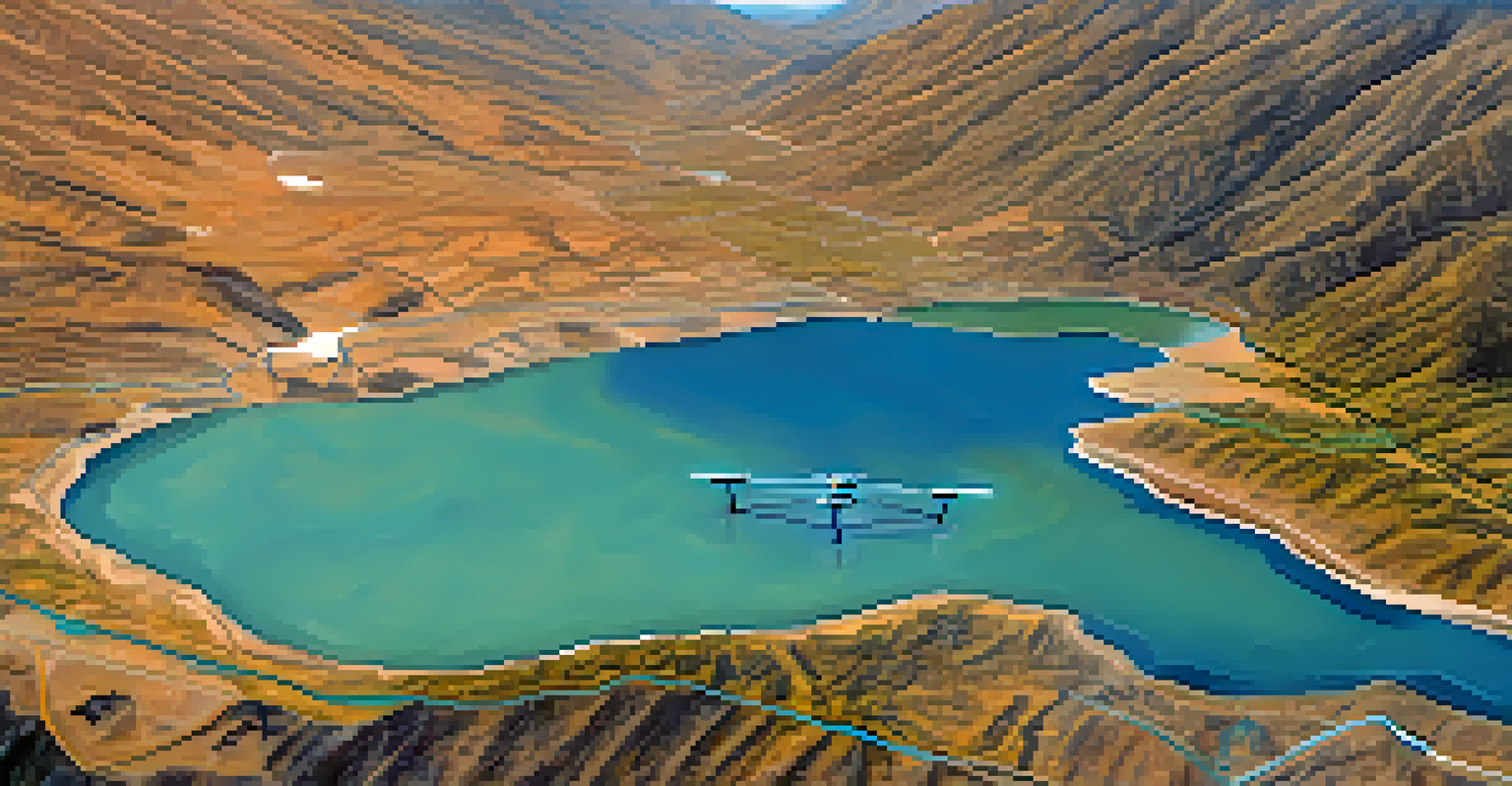The Role of Technology in California's Water Resource Management

Understanding California's Water Management Challenges
California faces significant challenges with water scarcity, especially given its diverse climate and growing population. The state experiences periodic droughts, which put immense pressure on water resources. This scenario demands innovative solutions to manage water effectively and ensure sustainability for future generations.
Where water is concerned, an ounce of prevention is worth a pound of cure.
With agriculture being a cornerstone of California's economy, the competition for water between agricultural needs and urban growth intensifies. Farmers often find themselves in a struggle to secure enough water for their crops, while cities aim to provide for their increasing populations. Understanding these challenges is crucial to appreciating the role of technology in water management.
Moreover, aging infrastructure and outdated management practices further complicate the situation. As demand for water increases, the need for smarter, more efficient systems becomes more pressing. This is where technology steps in to provide potential solutions.
The Role of Data Analytics in Water Management
Data analytics plays a pivotal role in optimizing water use and management strategies. By collecting and analyzing data from various sources, water managers can make informed decisions that help conserve resources. For instance, real-time data on water usage patterns can pinpoint areas where conservation efforts are most needed.

Advanced analytics can also help predict water demand, allowing for better planning and allocation of resources. By understanding historical trends and patterns, managers can forecast future needs and adjust policies accordingly. This proactive approach ensures that water is used more efficiently, ultimately benefiting both the environment and the economy.
Data Analytics Optimizes Water Use
Utilizing data analytics allows water managers to make informed decisions, improve conservation efforts, and enhance resource allocation.
Additionally, data-driven insights can enhance collaboration among stakeholders, including government agencies, farmers, and urban planners. When everyone operates with the same information, it fosters a more unified approach to managing water resources, leading to more sustainable outcomes.
Smart Irrigation Systems and Agricultural Efficiency
In agriculture, smart irrigation systems are revolutionizing how water is used. These technologies use sensors and automated systems to deliver precise amounts of water based on real-time data about soil moisture and weather conditions. This not only conserves water but also improves crop yields, making farming practices more sustainable.
We never know the worth of water till the well is dry.
For example, farmers can now utilize moisture sensors that alert them when irrigation is needed, preventing overwatering and reducing waste. This technology not only saves water but also enhances crop health, leading to better harvests. It’s a win-win for both farmers and the environment.
Moreover, these smart systems can be integrated with mobile apps, allowing farmers to monitor and control irrigation remotely. This level of control empowers them to make timely decisions, further optimizing water use. As technology advances, we can expect even more innovative solutions in agricultural water management.
Drones and Satellite Technology for Water Monitoring
Drones and satellite technology are emerging as powerful tools for monitoring water resources. These technologies can capture high-resolution images and data over vast areas, providing insights into water levels, usage, and quality. This aerial perspective enables more effective management of water bodies and irrigation systems.
For instance, drones can quickly assess the health of crops and identify areas suffering from water stress. By detecting these issues early, farmers can take action to address them, ensuring that water is used where it’s most needed. This proactive monitoring can lead to more efficient resource allocation.
Smart Irrigation Boosts Efficiency
Smart irrigation systems leverage real-time data to optimize water delivery, conserving resources while improving agricultural output.
Satellites also play a critical role in tracking changes in water bodies, such as lakes and reservoirs. By analyzing satellite imagery, researchers and water managers can observe long-term trends related to water availability and environmental impacts. This data is vital for planning and responding to droughts or floods.
Water Recycling Technologies and Sustainability
Water recycling technologies are becoming increasingly important in California's water management strategy. These systems treat wastewater and make it safe for reuse, significantly extending the available water supply. By implementing advanced treatment processes, communities can recycle water for irrigation, industrial use, and even potable applications.
For example, some cities have developed programs to treat and reuse greywater from homes, which can be used for landscaping or toilet flushing. This not only reduces the demand on freshwater sources but also promotes a culture of conservation within communities. People become more aware of their water use and its impact on the environment.
Moreover, water recycling helps mitigate the effects of drought by creating a more resilient water supply. As California continues to face unpredictable climate patterns, the ability to recycle and reuse water will be critical in ensuring sustainable water management for the future.
The Impact of Mobile Technology on Water Conservation
Mobile technology is playing a significant role in promoting water conservation across California. With the rise of apps that track water usage, homeowners and businesses can monitor their consumption and identify areas for improvement. These tools empower individuals to take control of their water use, making informed decisions about conservation.
For instance, some apps provide tips on reducing water waste, while others allow users to set alerts when they exceed their usual consumption levels. This level of awareness can motivate people to change their habits, leading to significant reductions in water usage. It’s a great example of how technology can foster a culture of conservation.
Mobile Tech Promotes Conservation
Mobile applications empower individuals and businesses to track water usage, fostering a culture of conservation and informed decision-making.
Additionally, mobile technology can enhance communication between water providers and consumers. By sharing real-time information about water availability and restrictions, agencies can keep the public informed and engaged in conservation efforts. This transparency builds trust and encourages community participation in sustainable water practices.
Future Trends in Water Management Technology
As we look to the future, emerging technologies are set to further transform water management in California. Innovations such as artificial intelligence (AI) and machine learning are beginning to play a role in predicting water demand and optimizing resource allocation. These advancements will enable even more efficient and effective management of water resources.
Moreover, the integration of the Internet of Things (IoT) in water management systems allows for continuous monitoring and data collection. With interconnected devices, managers can gain real-time insights into water usage and system performance, leading to timely interventions and better decision-making. This level of connectivity can revolutionize how water resources are managed.

Finally, public awareness and education about these technologies will be crucial for their successful implementation. As communities become more knowledgeable about the tools available to them, they can better participate in water conservation efforts. Together, these trends will shape a sustainable future for California's water resources.